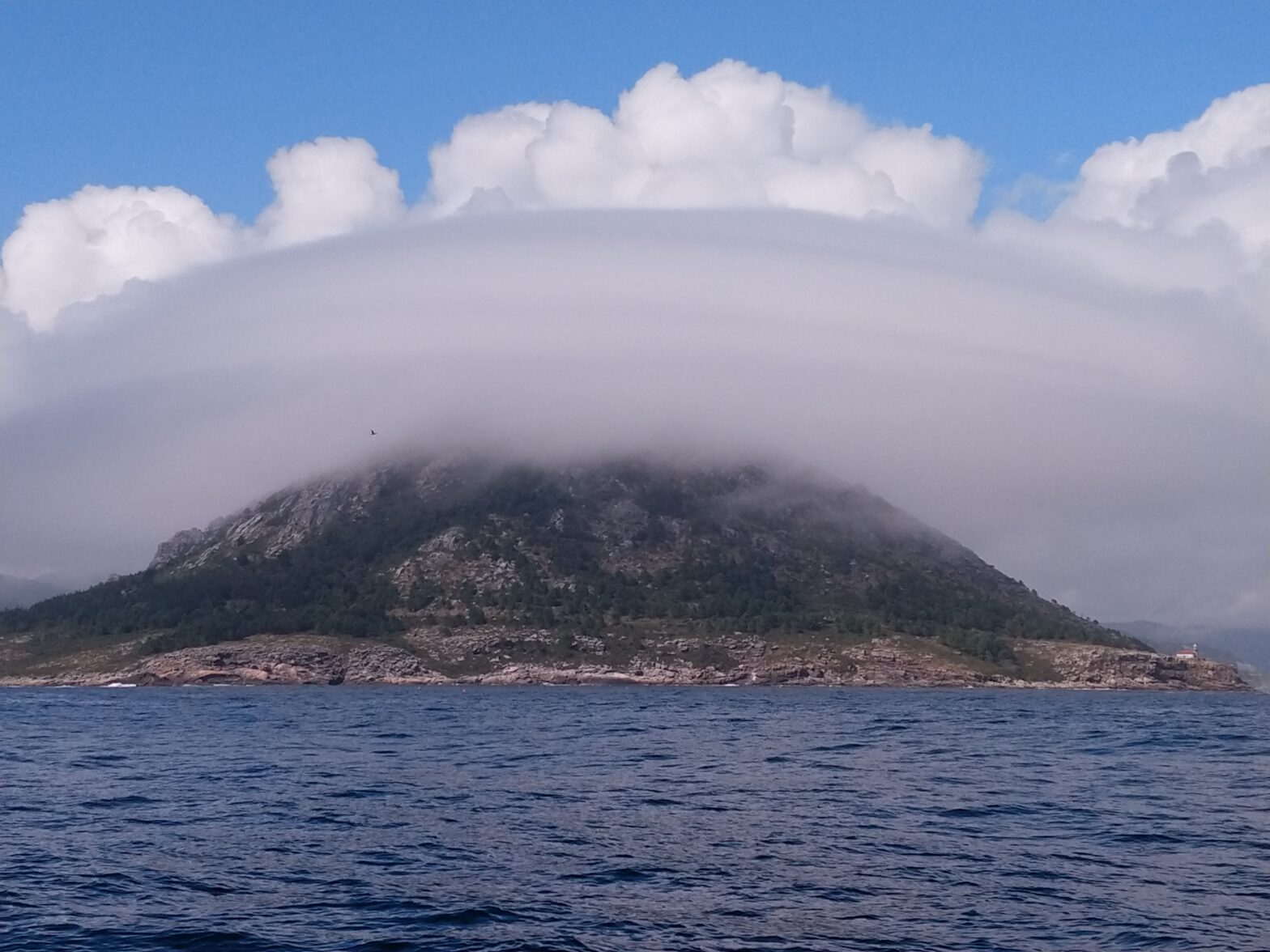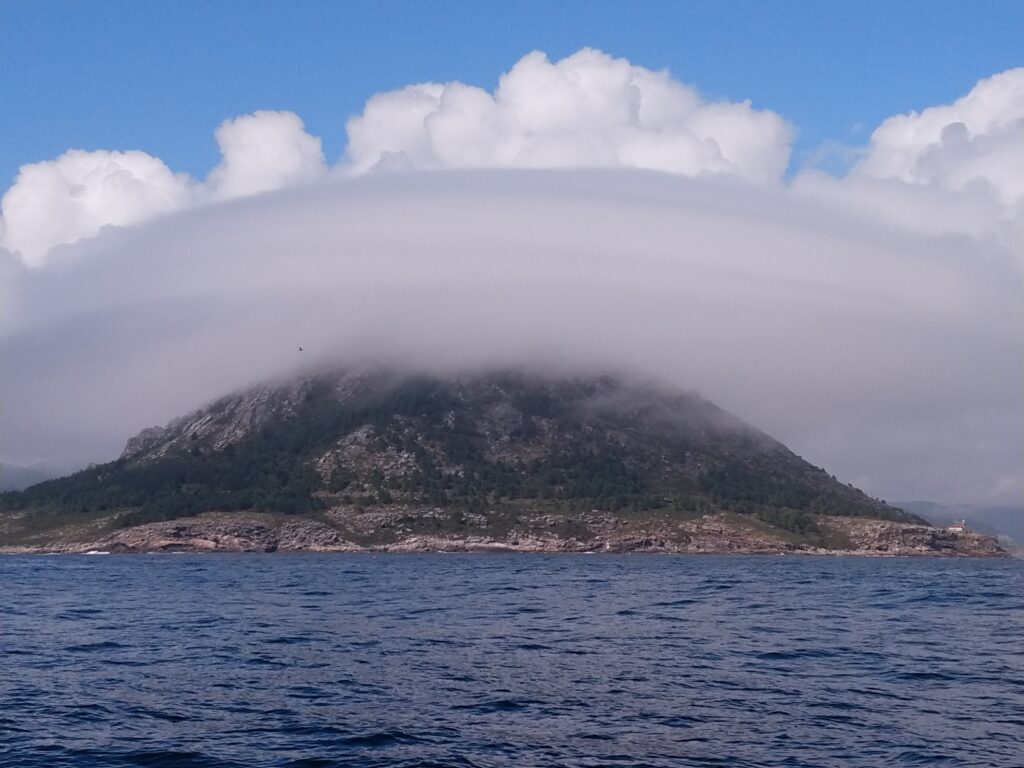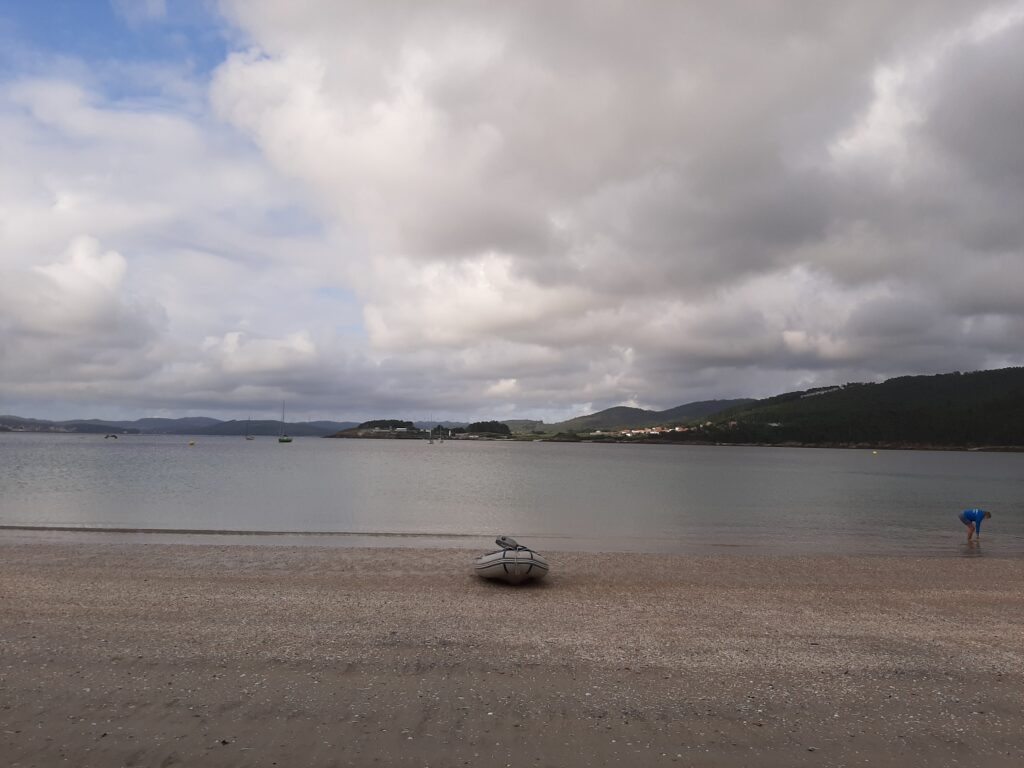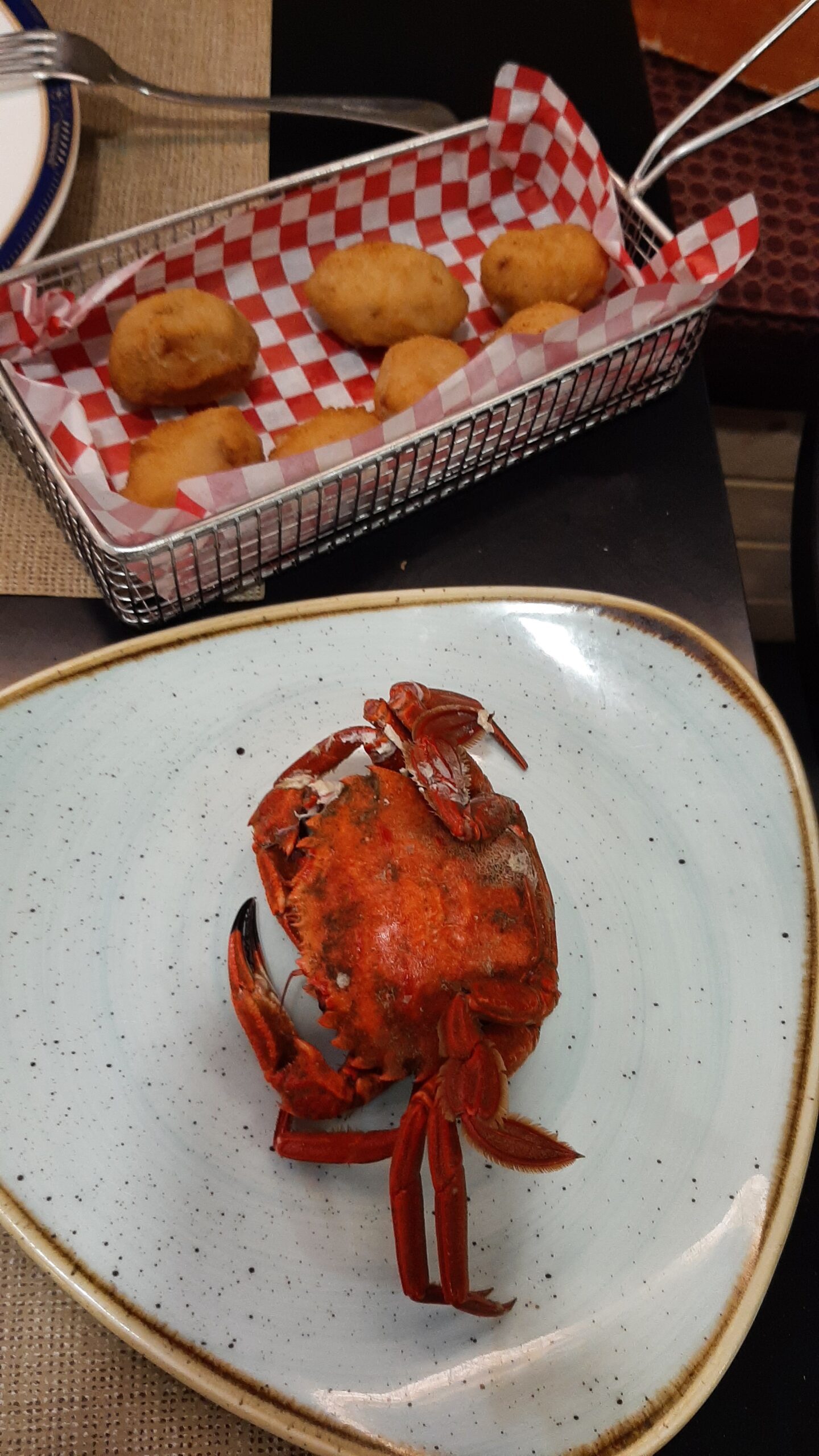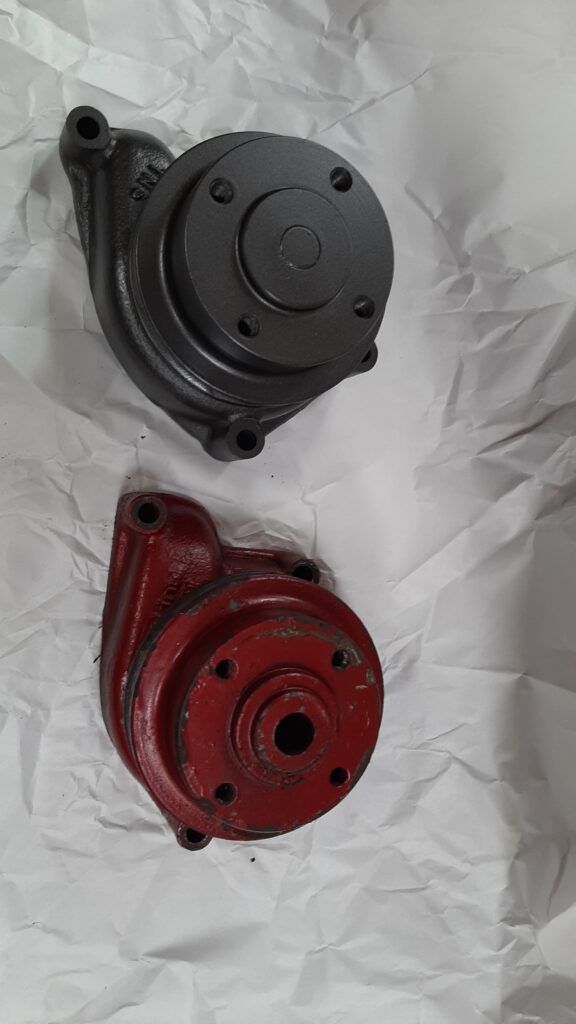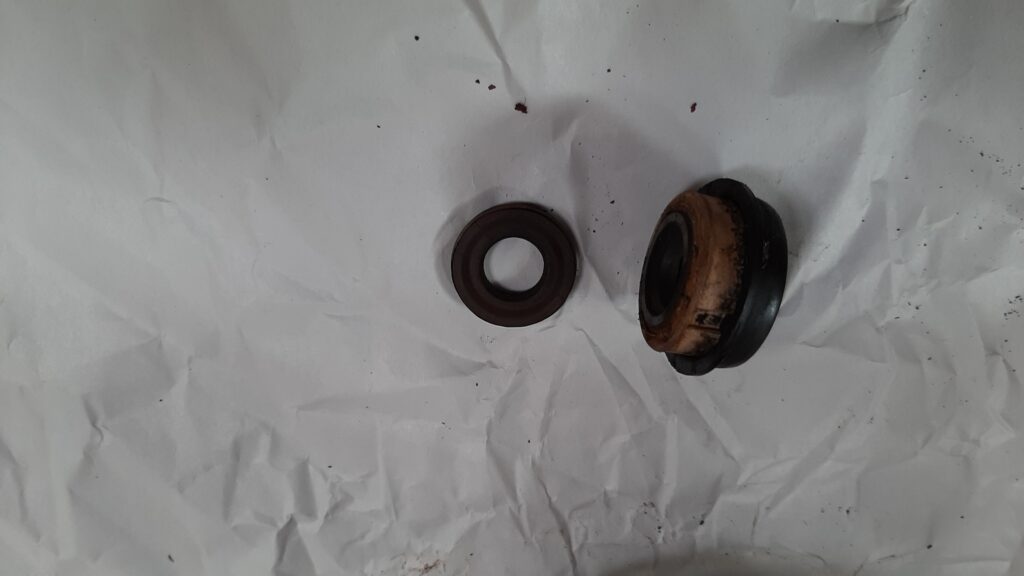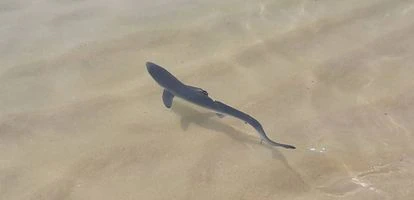Yes, we also saw our first shark. And blue sharks too, according to Wikepedia “… from the family of requiem sharks (also known as predatory sharks, Carcharhinidae),the family responsible for most attacks on humans.” That sounds exciting and gives a nice headline above this story. But the content is only at the end of this piece, so also a real cliffhanger and as usual the actual story is rather disappointing in the end. You’ve been warned.
I write this piece when we are anchored near a small town in the Ria of Muros and Noia. This morning we woke up to a church bell playing a melody that sounds like “see over there, the steamer is coming” (a Dutch Sint Nicolaus song). And because we’re in Spain (and Sint Nicolaus is from Spain) it is correct, but it still sounds weird. Yesterday we were able to (finally) leave Muros after the problems with the water pump seem solved. We moved up a little bit and anchored. Nice that we are outside a marina again and also nice that the engine seems to be working again, but more about this later.
It’s been a while since we left Coruña. When we set sail, it seemed that we went through the water a little easier than before. We had already noticed that after mooring in the port of Coruña, all fish rushed to our boat immediately to accommodate the (Dutch?) growth that was under water on the boat. A treat apparently, because when we were inside in the cabin, we could hear the fish mouths over the bottom of the boat. And it looks like it helped and we got some speed back.
By the way, there was also that little problem with the rudder, which occurred after the last stretch in the Biscay Bay. In Coruña, I put on my wetsuit, goggles with snorkel and went into the water in search of the problem. Didn’t really find anything serious. Loosening the lower rudder bearing gave enough solace: the rudder moved smoothly over the full travel. What exactly is the culprit is hard to determine. Last winter in the Netherlands I had just taken care of the rudder bearing in my workshop on the milling machine to get the clearance out. Maybe then I machined it a little too tightly.
Working underwater is quite difficult by the way: you have a lot of buoyancy (also because of that wetsuit) so you always have to pull/push yourself under water, while your tools are lacking buoyancy so you secure everything anxiously with lines to yourself so as not to lose anything to the bottom. When working underwater, it also turned out that the underwater ship had been quite eaten by the local fish: only the hard barnacles (remains) are still on the hull. Something we will really have to take off ourselves….
There’s a lot of fish here anyway. Not only in the ports but also outside. And some of those fish have a habit of wandering down the surface of the water in the morning in search of food, often right next to your boat. A funny scene. Also seen a lot of dolphins, but not (yet) right next to the boat. And of course there is also a lot of fishing, and that gives the possibility to eat very tasty, very fresh fish and other marine animals on shore!
So, after Coruña into the Rias. Beautiful bays with many beaches, villages, harbors, anchorages, etc. And the weather also gets a bit better, which makes everything more beautiful than before. On the way to those Ria’s you pass the “Costa Muerte” and “Cap Finesterre”. Illustrious names that inspire a certain awe. For us, it was not so bad: a lack of wind and waves rather than too much at the time we sailed past it. In the first Ria we visit is Camariños. Once anchored, we decide to take care of our windcharger. I had already replaced the bearings of the windcharger, but I had then fixated the charger for a winter which resulted in water entering the (stationary) bearings and ruining them. Running the charger gave the idea that there was a big coffee grinder grinding somewhere when you were in the boat. So, the bearings had to be replaced. At such a moment it is a pity that you cannot take your entire workshop on board: the bearings have to be pulled off an axle which can only be done with decent pulleror other solid tools. Unfortunately, I don’t have those with me, so in Camariñas I was looking for some workshop where they could take the bearings off. Now in justy about every village they have some kind of workshop where the locals can come along with whatever-needs-to-be-repaired, and certainly in places with something of a fishing fleet. The same goes for Camariñas.
It took a bit of searching and being referred to (in unadulterated, unintelligible and incomprehensible Galician), but in the end we found one. Upon entering, you got struck by the smell of sharpened, welded and freshened metal and where you were surrounded by many lathes and milling machines, drill presses and band saws, and other things that make a workshop a workshop. Marvelous. The only pity is that if you look closer everything seems a bit worn out, and that the old man you are referred to who is working there goes out of his way to make something of it but does not excel in subtlety and (of course) does not speak a word of English. After some hands and feet consultation in which it became clear to him (as it seemed) what was the problem and what needed to be done, it turned out that the only bearing puller present had had his best time, and after two fruitless attempts with a vice and a hammer, the man reached for his favorite tool: the angle grinder. With fear and tremble, I watched as the man then cut off both bearings from the windcharger rotor. And, to be honest, he succeeded without too much collateral damage. Only once he slipped and the grinder dug itself into the vulnerable rotor with the copper windings. But, as he made it clear to me afterwards with some shame but also pride: he didn’t cut quite through it though, only a little bit! So, it should still work…. (Once on board and the windcharger back together, it did indeed (fortunately) still function).
After the Ria of Camariñas and Muxia we continued to the Ria of Muros and Noia. First a night in the marina to be able to shower and (literally) refuel and then anchor again (right 😊) in front of the marina. A day later we decided to move a bit to another the anchorage, about 5 miles further into the ria, but we were hardly on our way or we heard a strange noise: the alarm of the engine panel started beeping because the engine ran too hot. So, we quickly shit down the engine, and set sail to get to the side with the little bit of wind that was there to be able to anchor. When I went in to the engine compartment it was found that the coolant level was far too low, it then soon became apparent that the (coolant) pump leaked and the coolant therefore (partly) ran into the bilge instead of being pumped through the engine. Hmmm, annoying and not easily fixed. So, let’s get back to the docks, on sail. Refill the coolant to allow the last part to be done with the engine to enter the port and to be able to moor. Once in the berth In went into the engine room to disassemble the water pump. Unfortunately, it also shows how unfortunate it is that you cannot take your entire workshop on a boat because here too some special tools are needed to be able to completely disassemble the pump for inspection. So then again we had to look for a local workshop….….
In this village also, a workshop was present, and proportional to the size of the fishing fleet also quite skilled in (boat) engines. And of course again no English here, and given my limited Spanish and Galician we resorted again to mainly hands, feet, and Google translate. In the end it turned out that they could not get the relevant parts to repair the pump. However, they were able to supply a new pump for a mere 200,- Euro. Not quite what we hoped for. We had actually already decided that morning to order a new pump over the internet. If the old one could be repaired, we would keep it as a spare. Being able to find a pump via the internet for 73 Euro, even with courier delivery costs, it saved us considerably. Three days later the pump came in and after assembly it seems that the problem has actually been solved. And because we were not going anywhere during those days and I was working on the engine anyhow, some maintenance was done as well (oil + filter changed, impellor replaced). Hopefully the old beast will keep running again. For the enthusiasts: this is a Perkins 4.108 from 1980. Sometime (in 1996?) overhauled and ran about 1800 hours since. Not the youngest, but should be able to still last a while! Its nickname is “the smoke machine” because it puts out quite a bit of smoke on a cold start. Once warmed up (or preheated by the calorifier with shore power) everything is fine.
And to conclude the story with the sharks: Both in the harbor and in the sea, we have seen a number of baby blue sharks swimming. Some Googling revealed that they were becoming more and more common on the Galician coast and in the Rias. They look cute and beautiful as a baby, with a beautiful blue color, and they were about 50 cm long, but luckily the adults stay in their normal habitat of more than 200 miles off the coast! Though it is fascinating how those babies then swim 200 miles to get here …..
